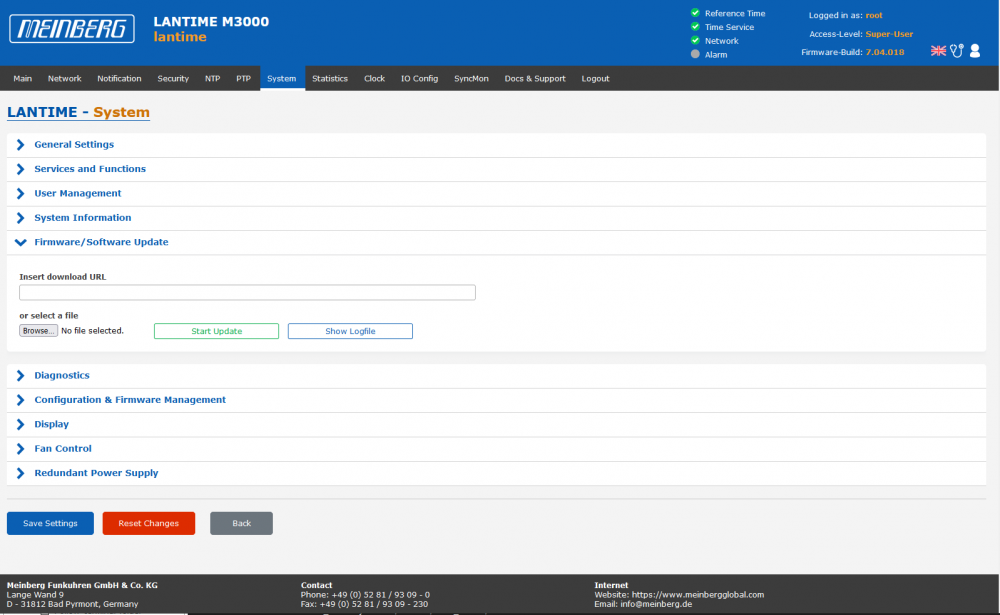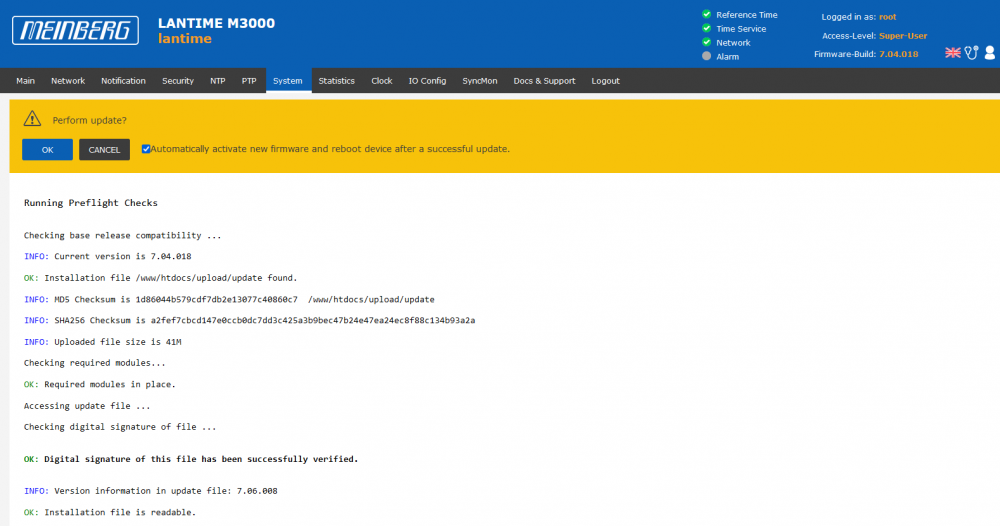LANTIME: Firmware Updates in LTOS V6 and LTOS V7
This article describes how to update the LTOS (LANTIME Operating System) firmware when a LANTIME is running LTOS V6 or LTOS V7.
In principle, there are 3 different ways how to perform the update.
It can be done via…
- Web Interface
- Command Line Interface (CLI)
- Front Panel Display and USB memory stick
Update via Web Interface
Connect to the web interface and open the Firmware/Software Update menu on the System page. Use the Browse button to select the update file from your local hard drive. Once the file has been selected, the update can be started pressing the Start Update button:
After the upload has finished, you are prompted to confirm the start of the update process. If you tick the Automatically activate new firmware and reboot device after a successful update. checkbox, the LANTIME will automatically reboot and come up with the new firmware. If you don't tick the checkbox, you can activate the new firmware later on the System page –> Configuration & Firmware Management
Update via CLI
- Copy the update file into the directory
/www/htdocs/uploadusing SCP/WinSCP or copy the file to an USB stick (FAT32 filesystem) and plug it in the USB front connector of your LANTIME - The access to the Command-Line-Interface can be established through SSH, Telnet or serial connection. Logging in with a super user account is necessary, otherwise you won't be able to use the CLI. The default user of a LANTIME is
rootand the password istimeserver. - After the connection has been established, the login message will be displayed. To perform the update, you have to proceed as follows:
- Start the update process using the following command
sudo chkupdate /www/htdocs/upload/[name of updatefile]
or in the case the update file is stored on an USB stick:
sudo chkupdate /mnt/usb_storage/[name of updatefile]
so for example:
sudo chkupdate /www/htdocs/upload/firmware-7.06.009-x86.rel
- After the installation of the update the firmware is not activated automatically. Run the following command to list all installed firmware versions.
fwlist
Example output of the fwlist command:
OSV fw_7.04.018 fw_7.06.009
- To activate a firmware image enter the command
sudo fwselect [name of firmware]
Enter the name of the firmware as it's displayed in the output of the fwlist command. So for example:
sudo fwselect fw_7.06.009
- Reboot the LANTIME with the command
sudo reboot
- The LANTIME will come up with the newly activated firmware
Update via Front Panel Display and USB Memory Stick
The update can also be installed by using an USB stick. Please make sure that the stick is using the FAT/32 filesystem. Copy the LANTIME updatefile to the USB stick and plug the stick in the USB connector of your LANTIME.
Once the stick has been inserted, the following message should appear in the display:

Proceed with OK. You will now be able to choose between various options using the “Arrow up” and “Arrow down” buttons of the LANTIME. The LANTIME will automatically detect the existing updatefile on the usb stick and provide the update option.

Press OK again to start the update process.
After installation of a new firmware via USB stick, the firmware needs to be manually activated using CLI or WebUI. This has already been described in the previous chapters.
Further Assistance
If further assistance is required, contact Meinberg Technical Support: https://www.meinbergglobal.com/english/support/tech-support.htm
— Manuel Schäfer manuel.schaefer@meinberg.de, last updated 2023-05-16

